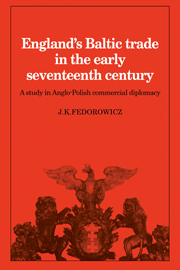 England's Baltic Trade in the Early Seventeenth Century
England's Baltic Trade in the Early Seventeenth Century Published online by Cambridge University Press: 05 November 2011
English relations with the southern shore of the Baltic can be traced back to the ninth-century voyage of Wulfstan to ‘Trusco’, identified by recent historians with the present-day Lake Drausen (Druzżno) near the town of Elbing (Elblag) in northern Poland. Commercial relations must have developed in the subsequent centuries as there is evidence of a regular English trade to the Baltic by the thirteenth century. By the year 1390, King Richard II granted a set of privileges to the merchants plying this trade though the extent to which this trade was organized or protected by the English government seems to have varied according to the external competition and threats it confronted.
There is literary evidence dating from the fifteenth century which suggests that England's Baltic links were already a significant element in the expansion of its commercial interests. The Libelle of Englyshe Polycye dating from 1436 mentions imports ‘fro Pruse’ (Prussia) of beer, bacon, copper, bowstaves, steel, wax, skins, pitch, tar, boards, flax, threads, linens and canvas, noting that ‘of olde tyme thus it wase’. In return, Prussian merchants took from England woollen cloths of all colours ‘by dyers crafted ful dyverse’, which clearly means finished cloths, not the unfinished white cloths normally exported to the Netherlands. Of even greater significance is the description of imports of Prussian plates of silver and ingots of gold, signifying that the value of finished English cloth exports to Prussia exceeded that of the raw materials imported in exchange: England enjoyed a positive trade balance with Prussia ‘which is increase ful grete unto thys lande’.
To save this book to your Kindle, first ensure [email protected] is added to your Approved Personal Document E-mail List under your Personal Document Settings on the Manage Your Content and Devices page of your Amazon account. Then enter the ‘name’ part of your Kindle email address below. Find out more about saving to your Kindle.
Note you can select to save to either the @free.kindle.com or @kindle.com variations. ‘@free.kindle.com’ emails are free but can only be saved to your device when it is connected to wi-fi. ‘@kindle.com’ emails can be delivered even when you are not connected to wi-fi, but note that service fees apply.
Find out more about the Kindle Personal Document Service.
To save content items to your account, please confirm that you agree to abide by our usage policies. If this is the first time you use this feature, you will be asked to authorise Cambridge Core to connect with your account. Find out more about saving content to Dropbox.
To save content items to your account, please confirm that you agree to abide by our usage policies. If this is the first time you use this feature, you will be asked to authorise Cambridge Core to connect with your account. Find out more about saving content to Google Drive.